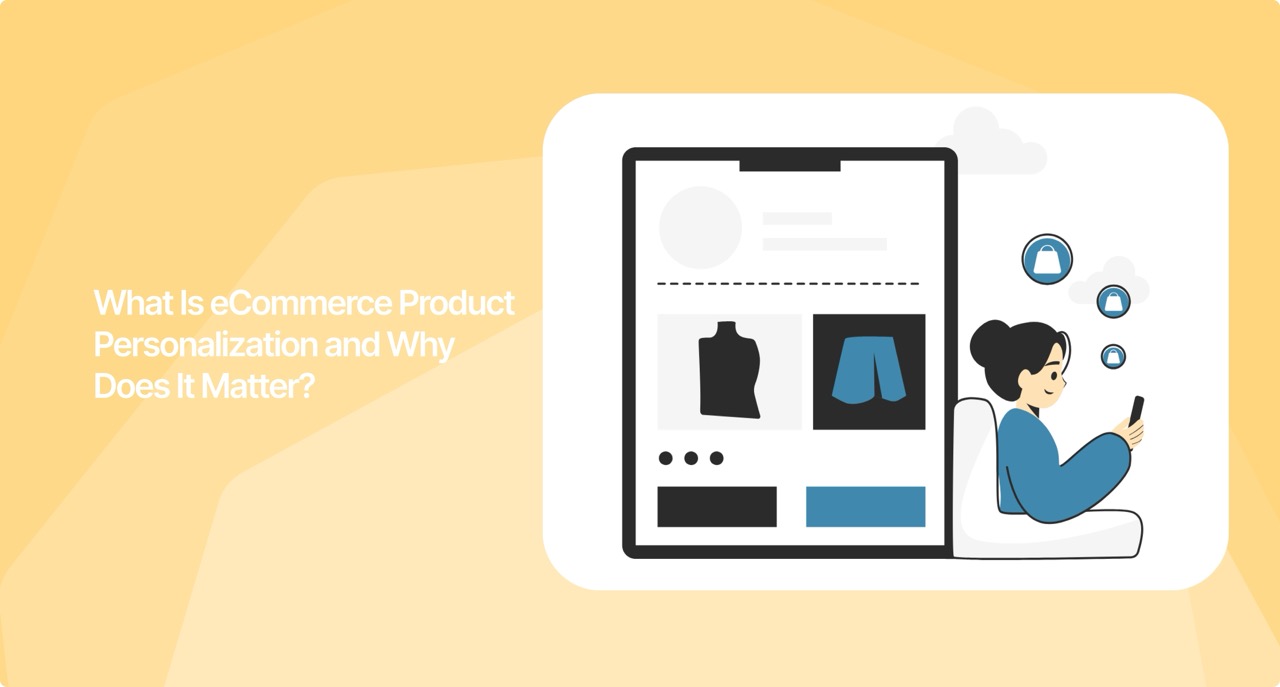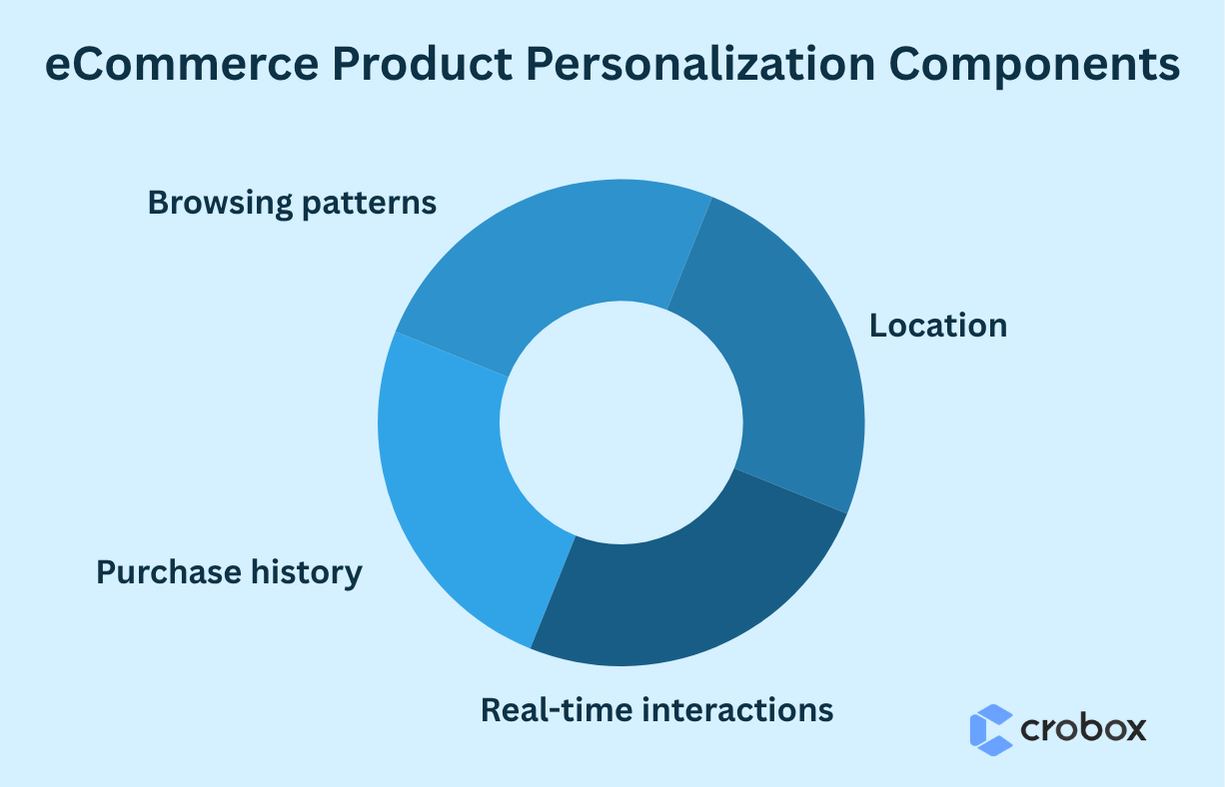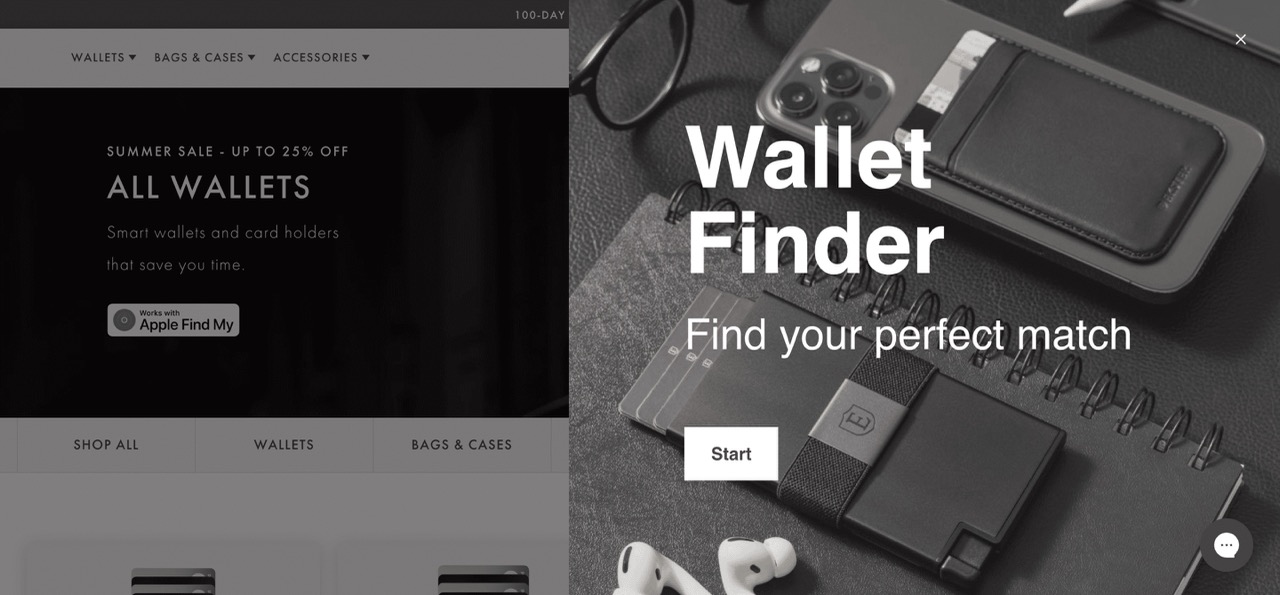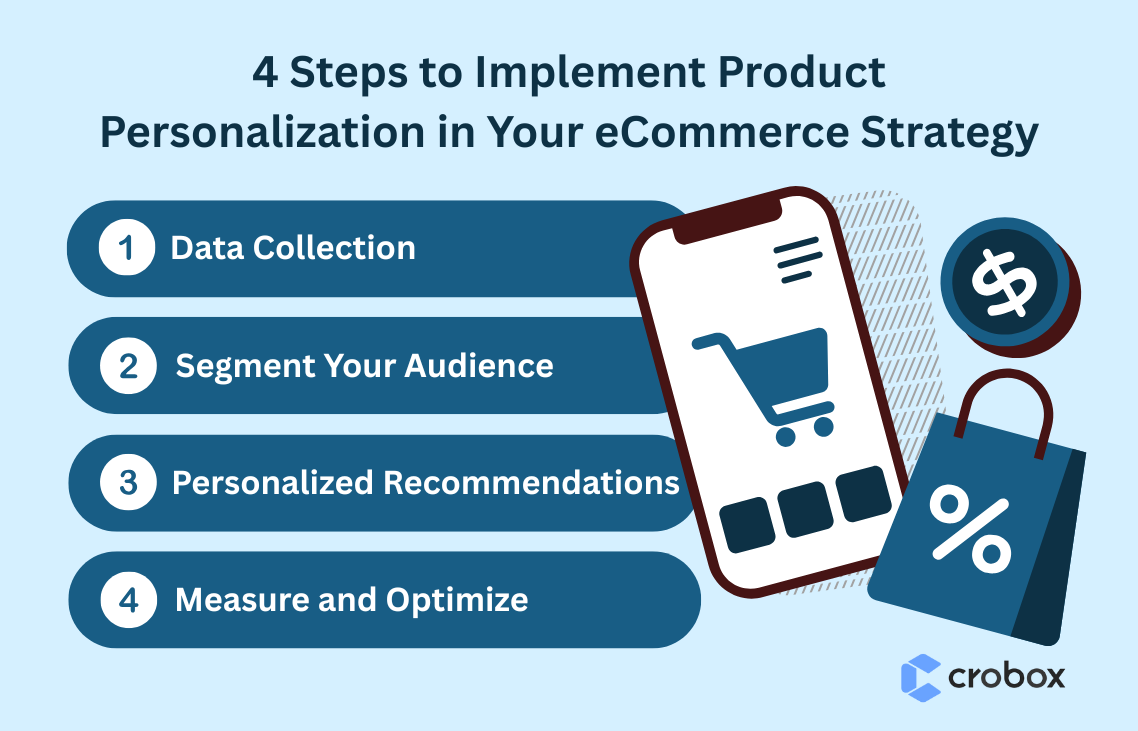
Every shopper is different, so why serve them the same experience? Customer expectations constantly change and eCommerce product personalization has become essential for brands looking to stay competitive. It is no longer enough to offer a wide selection of products and retailers must provide product experiences that reflect each shopper’s unique preferences.
Personalized shopping experiences boost customer engagement, decrease bounce rates, increase average order value (AOV), and ultimately drive higher conversion rates. When shoppers feel understood, they are more likely to trust your brand, stay longer, and complete their purchase.
This is exactly why Crobox’s Product Finder becomes a no-brainer. Powered by behavioral data and AI, Crobox helps brands personalize the product discovery process in real-time, offering the right products to the right people at the right moment. It results in enhanced customer satisfaction, smarter purchase decisions, and scalable sales growth fueled by data-driven personalization.
Product personalization in eCommerce is a process of making the shopping experience meet the unique needs, preferences, and behaviors of each individual customer. eCommerce brands deliver highly relevant product recommendations, dynamic messaging, and content that speaks directly to each shopper by using a combination of:

This level of personalization in eCommerce goes far beyond simply addressing a customer by name. It is about curating a flawless journey that feels intuitive and helpful at every touchpoint, from homepage banners to category filters, and most importantly, product discovery. When shoppers are shown products that perfectly align with their needs, they are more likely to engage, convert, and return back for more.
With the help of AI and machine learning, brands can now personalize at scale, adapting in real time to changes in customer behavior. Tools like Crobox use AI-driven insights to fine-tune the personalization process, ensuring each customer receives the right product suggestions at the right moment.
Personalization is a proven growth driver for modern eCommerce brands. When done right, it creates a frictionless path to purchase that benefits both the customer and the business. Here are some of the key advantages of implementing product personalization in eCommerce:
With AI-powered tools like Crobox’s Product Finder, brands can use behavioral and contextual data to personalize the entire product discovery journey. This approach can bring more sales and set the foundation for further growth through smarter customer experiences.
A personalized shopping experience does not just feel better, it performs better. eCommerce product personalization influences every stage of the customer journey, from product discovery to checkout. With a lower rate of friction and presenting more relevant choices, personalization helps customers to make confident decisions faster, which leads to higher satisfaction and more conversions.
Shoppers are often overwhelmed by too many choices, especially when going through large catalogs. Personalized product recommendations help reduce this choice overload by filtering the most relevant options based on a shopper’s behavior, needs, and preferences. This simplifies the browsing process, improves product discovery, and drives stronger purchase intent.
Crobox’s Product Finder elevates personalization in eCommerce by delivering real-time recommendations tailored to each shopper’s unique needs. Crobox ensures that every recommendation is timely, contextual, and conversion-friendly when it comes to showcasing top-rated items, frequently purchased products, or behaviorally triggered suggestions.
Case in point: Crobox helped ASICS achieve a 52% increase in conversions by personalizing product recommendations based on behavioral profiles and product attributes.
The final stages of the customer journey are crucial and personalization plays a big role in helping shoppers cross the finish line. A personalized shopping cart or checkout page can surface relevant upsells, timely discounts, or even reminders based on previously viewed items.
This creates a smoother and more relevant path to purchase that feels tailored rather than pushy. Crobox integrates easily into these moments, offering an intelligent approach and dynamic messaging that guide customers without overwhelming them. Even if we talk about suggesting a complementary product or highlighting a low-stock item, Crobox’s AI ensures every prompt is grounded in real-time behavior and relevance.
Case point: Crobox helped Ekster achieve 41.5x ROI with a Wallet Finder to help shoppers discover better gear for life on the go.

To unlock the full potential of eCommerce product personalization, brands must go beyond surface-level tactics and invest in data-driven strategies. With a full focus on behavioral insights and extending personalization beyond the point of sale, online retailers can create richer and more meaningful interactions that drive easy conversions and long-term customer loyalty.
Behavioral targeting and segmentation are foundational to personalization in eCommerce. This strategy involves grouping customers based on real-time and historical data, such as browsing behavior, product interactions, time spent on site, and purchase history. Once segmented, businesses can deliver tailored product recommendations, offers, and messaging that match each shopper’s intent and lifecycle stage.
For example, a first-time visitor will respond better to bestsellers or reviews, while a returning customer may be more interested in top-up reminders or exclusive deals on previously purchased items. The more relevant the message, the more likely it is to convert.
Crobox enables brands to tap into this potential with AI-powered behavioral insights that adapt in real-time. If your goal is to boost conversions or increase AOV, Crobox is here for all marketers to deliver the right message to the right person at the right time.
We have to mention that Crobox’s behavioral insights helped LoveStories increase AOV by 15% by tailoring product recommendations to shoppers’ preferences.
Personalization does not end at checkout. Some of the most powerful opportunities to build loyalty happen after the first purchase. Post-purchase personalization includes tactics like personalized thank-you emails, relevant product recommendations for future purchases, exclusive discounts, and personalized content that grows customer relationships.
By continuously engaging your customers based on what they have bought and how they interacted with your brand, you keep them in the ecosystem and encourage repeat purchases. For subscription-based businesses, this can mean suggesting the right product for their next order. For fashion retailers, it could be styling tips or “Complete the Look” emails based on past purchases.
Crobox helps brands extend the value of personalization in eCommerce into the post-purchase phase with smart follow-up strategies that deepen engagement and create stronger emotional connections.

Successfully implementing eCommerce product personalization is not about throwing in a few product suggestions and hoping for the best. It is a strategic and ongoing process that requires a clear understanding of customer behavior, smart segmentation, and powerful tools like Crobox to bring it all to life. Below are the four essential steps to help you turn personalization from concept into conversion. Let’s check them all:
The first step to delivering a personalized shopping experience is collecting the right data, specifically, zero-party and first-party data that gives you direct insights into how your customers interact with your store. Without accurate data, personalization in eCommerce becomes guesswork. Tracking customer behavior across your site means building rich user profiles that bring smarter recommendations for the target customers.
Examples of valuable first-party data include:
Collecting this data ethically and transparently lays the groundwork for customer trust and future personalization efforts.
Once you have collected actionable data, the next step is segmentation. Segmenting your audience means grouping customers based on shared behaviors or characteristics so you can offer relevant experiences. Without segmentation, personalization and customization in eCommerce lose precision and impact. Effective segmentation includes:
Crobox helps automate and scale this process using AI to interpret behavior and place users into high-conversion segments on the fly.
This is the heart of most e-commerce personalization strategies. With tools like our Product Finder, you can deliver real-time product recommendations that align with each shopper’s preferences, context, and needs. AI-driven personalization ensures that the right products appear at the right time, creating a smoother path to purchase.
Examples of smart recommendation strategies are:
Crobox takes this a step further with adaptive messaging that not only recommends but also persuades helping increase AOV and reduce cart abandonment.
Personalization is not static and it changes with your customers. That’s why it is essential to continually measure and optimize the performance of your personalization strategies. Track how customers interact with personalized experiences and use those insights to improve your approach.
Key metrics to monitor include:
Crobox offers in-depth analytics to help brands adjust in real time, so personalization stays effective and aligned with shifting customer behavior.
No one wants to feel like just another click in the crowd. Modern shoppers are looking for journeys that speak to them, such as their tastes, their habits, and their vibe. That’s why personalization has become the core of successful eCommerce. But, doing it well, and at scale, is not easy. Most brands overcomplicate it or miss the mark entirely, so Crobox takes its moment to shine, making scalable eCommerce product personalization effortless.
The Product Finder delivers hyper-relevant product recommendations tailored to each individual’s behavior, preferences, and stage in the customer journey. Instead of overwhelming shoppers with too many choices, it simplifies discovery, reduces friction, and increases the likelihood of conversion.
What sets Crobox apart is its flawless integration. Even if you prefer Shopify, Magento, Salesforce Commerce Cloud, or any other major eCommerce platform for your store, Crobox plugs into your existing tech stack without requiring a full rebuild. Its API-first approach ensures consistent and scalable personalization across the entire customer journey, from landing page to checkout.
If you are looking to deliver truly personalized shopping experiences without technical headaches, Crobox is the partner that makes it happen. From behavioral segmentation to real-time optimization, Crobox helps eCommerce teams create high-converting and customer-first journeys. Book a demo today and make your personalization plans a powerful reality!
Product personalization in eCommerce means tailoring the shopping experience to individual users based on their behavior, preferences, demographics, and past interactions. This can include personalized product recommendations, dynamic content, targeted offers, and custom messaging, all designed to make each shopper’s experience more relevant and engaging.
Because consumers now expect it. Personalization increases customer satisfaction, drives engagement, and boosts conversions. When done right, it helps shoppers quickly find what they want, reducing decision fatigue and encouraging loyalty. For eCommerce brands, it’s a proven way to increase sales and stand out in a crowded market.
Personalized product recommendations use data like browsing history, purchase behavior, and customer segments to suggest items that are most relevant to each user. With tools like Crobox’s Product Finder, these recommendations are powered by AI and behavioral insights in real-time, making them feel like a perfect fit and genuinely helpful.
Start by collecting first-party data, such as user behavior and past purchases. Then segment your audience and use AI-powered tools like Crobox to deliver personalized experiences across the site, from homepage banners and product pages to cart and checkout. Continually test, measure, and optimize to improve performance over time.
The benefits of eCommerce product personalization are clear:
By making the shopping journey smoother and more relevant, personalization reduces the friction points that cause lost sales. For example, showing personalized discounts, urgency signals (such as “Only 2 left!”), or relevant product suggestions at checkout can give shoppers the extra push they need to complete the purchase.
AI is the engine behind effective eCommerce product personalization. It analyzes large volumes of data in real-time, tracking patterns, predicting preferences, and delivering matching experiences instantly. Tools like Crobox use AI to serve dynamic recommendations and continuously optimize the customer journey for better results.